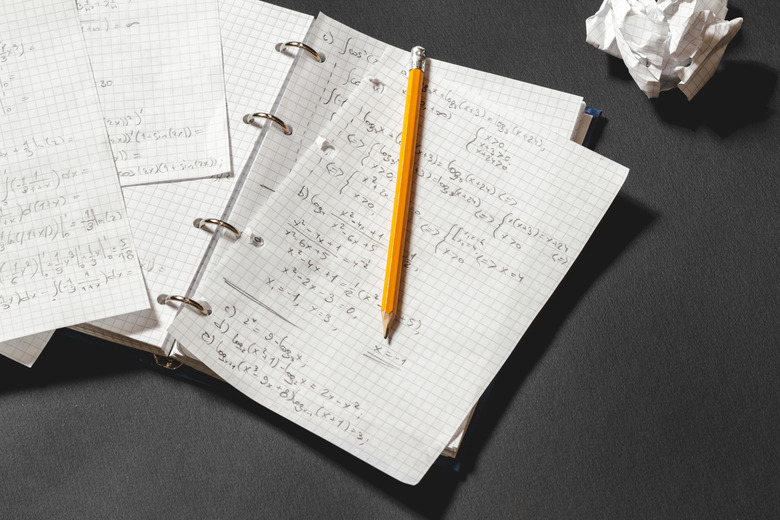What Is An Arithmetic Sequence?
In algebra, sequences of numbers are valuable for studying what happens as something keeps getting larger or smaller. An arithmetic sequence is defined by the common difference, which is the difference between one number and the next one in the sequence. For arithmetic sequences, this difference is a constant value and can be positive or negative. As a result, an arithmetic sequence keeps getting larger or smaller by a fixed amount every time a new number is added to the list making up the sequence.
TL;DR (Too Long; Didn't Read)
An arithmetic sequence is a list of numbers in which consecutive terms differ by a constant amount, the common difference. When the common difference is positive, the sequence keeps increasing by a fixed amount, while if it is negative, the sequence decreases. Other common sequences are the geometric sequence, in which terms differ by a common factor, and the Fibonacci sequence, in which each number is the sum of the two previous numbers.
How an Arithmetic Sequence Works
How an Arithmetic Sequence Works
An arithmetic sequence is defined by a starting number, a common difference and the number of terms in the sequence. For example, an arithmetic sequence starting with 12, a common difference of 3 and five terms is 12, 15, 18, 21, 24. An example of a decreasing sequence is one starting with the number 3, a common difference of −2 and six terms. This sequence is 3, 1, −1, −3, −5, −7.
Arithmetic sequences can also have an infinite number of terms. For example, the first sequence above with an infinite number of terms would be 12, 15, 18, ... and that sequence continues to infinity.
Arithmetic Mean
Arithmetic Mean
An arithmetic sequence has a corresponding series that adds all the terms of the sequence. When the terms are added and the sum is divided by the number of terms, the result is the arithmetic mean or average. The formula for the arithmetic mean is
\(\text{mean}= \frac{ \text{sum of }n \text{ terms}}{n}\)
A quick way of calculating the mean of an arithmetic sequence is to use the observation that, when the first and last terms are added, the sum is the same as when the second and next to last terms are added or the third and third to last terms. As a result, the sum of the sequence is the sum of the first and last terms times half the number of terms. To get the mean, the sum is divided by the number of terms, so the mean of an arithmetic sequence is half the sum of the first and last terms. For n terms a1 to an, the corresponding formula for the mean m is
\(m= \frac{a_1+a_n}{2}\)
Infinite arithmetic sequences don't have a last term, and therefore their mean is undefined. Instead, a mean for a partial sum can be found by limiting the sum to a defined number of terms. In that case, the partial sum and its mean can be found the same way as for a non-infinite sequence.
Other Types of Sequences
Other Types of Sequences
Sequences of numbers are often based on observations from experiments or measurements of natural phenomena. Such sequences can be random numbers but often sequences turn out to be arithmetic or other ordered lists of numbers.
For example, geometric sequences differ from arithmetic sequences because they have a common factor rather than a common difference. Instead of having a number added or subtracted for each new term, a number is multiplied or divided each time a new term is added. A sequence that is 10, 12, 14, ... as an arithmetic sequence with a common difference of 2 becomes 10, 20, 40, ... as a geometric sequence with a common factor of 2.
Other sequences follow completely different rules. For example, the Fibonacci sequence terms are formed by adding the previous two numbers. Its sequence is 1, 1, 2, 3, 5, 8, ... The terms have to be added individually to get a partial sum because the quick method of adding the first and last terms does not work for this sequence.
Arithmetic sequences are simple but they have real life applications. If the starting point is known and the common difference can be found, the value of the series at a specific point in the future can be calculated and the average value can be determined as well.
References
Cite This Article
MLA
Markgraf, Bert. "What Is An Arithmetic Sequence?" sciencing.com, https://www.sciencing.com/what-is-an-arithmetic-sequence-13712221/. 3 November 2020.
APA
Markgraf, Bert. (2020, November 3). What Is An Arithmetic Sequence?. sciencing.com. Retrieved from https://www.sciencing.com/what-is-an-arithmetic-sequence-13712221/
Chicago
Markgraf, Bert. What Is An Arithmetic Sequence? last modified August 30, 2022. https://www.sciencing.com/what-is-an-arithmetic-sequence-13712221/
